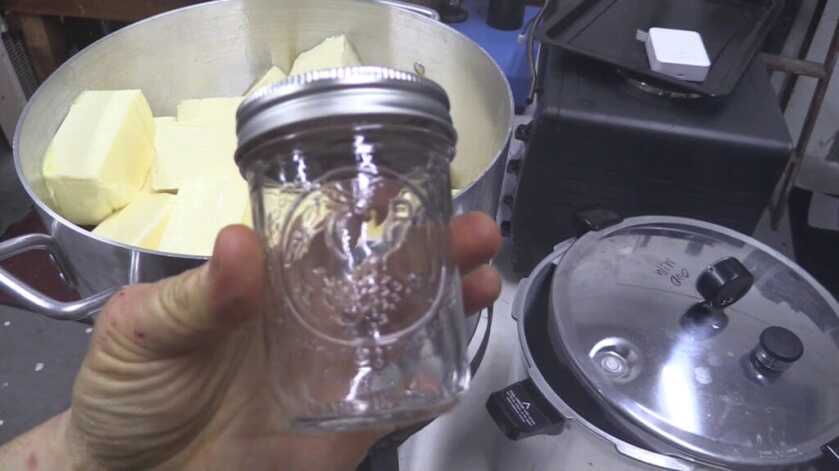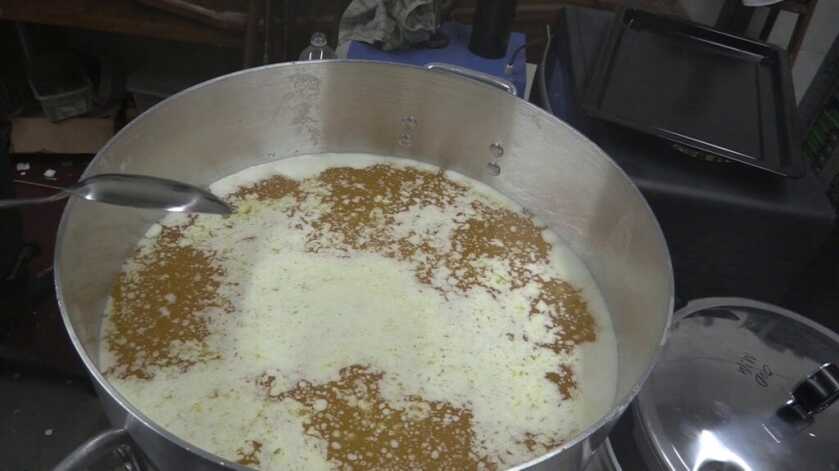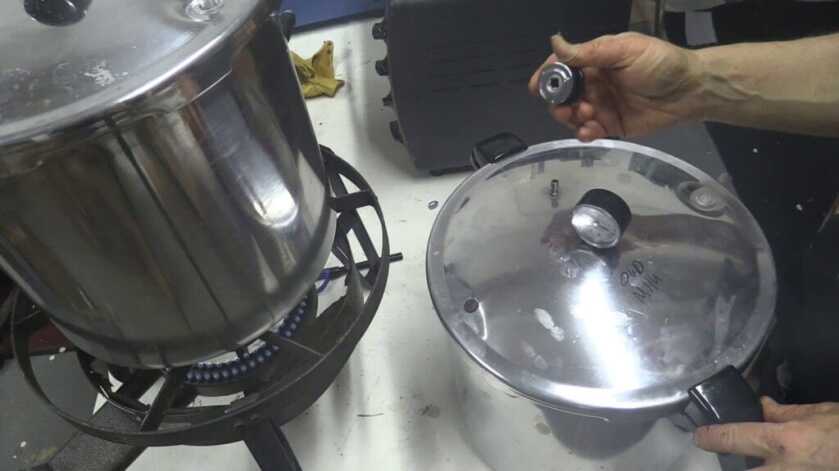I never thought that I would find something of value on TikTok, but lo and behold, there it was. My wife had sent me a video on how to can butter. I had never thought of canning butter. The video was short and to the point, meant for people who already knew how to can, so I decided to reboot Prepping 101 with a full overview of canning, using butter. As those of you old GunsAmerica Digest subscribers know, Prepping 101 isn’t about clickbaity fear porn. I do this stuff.

If you are already an experienced canner, the key takeaway to this methodology is to boil the butter and skim off the foam before you fill your jars. I suspect this is because whatever that stuff is does not taste good when canned for an hour or more, and it isn’t required. Using this methodology you will end up with a dipping butter that is generally liquid at room temperature. Though I did can a commercial brand of butter, not Land O’ Lakes, that got hard when it cooled.
For those of you who have never canned, I will take you through the process of what I do. This is not advice or instructions. Please refer to the lawyer vetted canning instructions on public government websites for that. You should note, regardless, that canning food is risky when not done correctly. I explain in the video why. Never can anything but tomato sauce and high acid fruits in an open top pot. You have to use a pressure canner made for that purpose.

The tools for canning are pretty simple, and usually available at your local Walmart. You will see that I used my steel cans primarily for myself, and I included them in this overview for those of you who bought the electric can sealers that I covered back in 2016. But mostly if you are starting out, your best bet is to use Ball jars or equivalent, which are on the shelves at most Walmarts for under $1 per jar. They also sell packs of lids so that you can reuse your jars down the line.

For home canning hot food that is not high in acid, like tomatoes, you absolutely have to have a pressure canning pot. There are two types of canning pots available online, the Presto line and the All American line. I suggest Presto, as the All American are prohibitively expensive now.
In my experience the Presto canners do not fail or degrade as long as you don’t run them dry. If you run them dry, they do tend to warp, but I have had no failures in the warped pots personally. There are two primary models, a 16 quart that has no pressure gauge, and a 23 quart with a pressure gauge. Walmart used to sell the 16qt in store, but I have not seen it for a while now. Both models are available online, at Walmart, Amazon, and sometimes Ebay.
The pressure gauge on a canner is somewhat superfluous. They merely verify that the weight is working correctly, and I suppose that if the vent got clogged they would tell you that you are overpressure. In practice that has never happened to me.
Whether a Presto or an All American, the weight is how you adjust the pressure. It sits on top of a vent, so that steam escapes right at that pressure, keeping the pressure level. The 23 quart Presto is set at 15lbs., but the 16 is adjustable down to 5, as is the All American.

Your first step in canning butter is to of course melt your butter. I was able to buy cases from Restaurant Depo, and you might well to know that most of those stores will give you a one day pass, so that even if you aren’t a restaurant owner, you can shop there. For prepper food there is no comparison when it comes to how much food is on the shelf.
Once the butter is melted, the TikTok video said to boil it and skim off the foam from the top, so I did. I don’t know what the foam is or if it actually matters, but with limited time on my hands, I would just as soon follow what has worked for other people.
You do not need to remove the solids that will be at the bottom of the pot, as you would if you were making clarified butter.
Once you have skimmed it, you can fill your jars and cap them. As I explained in the video, canning hot food is the easiest for all canning, because as the can cools, it creates it’s own vacuum.

After your jars are full, screw down your rings. Now, if you are shopping at Walmart for canning stuff, you will see that Ball makes a wrench looking thing for the rings on the jars. That is not to tighten them. When you pressure can, air will escape the lid, so only tighten the ring to finger tight. Mostly the ring is there to hold the lid in place during the pressure canning process. The lid will naturally seal itself and suck the middle in so that it no longer clicks.
Now you are ready for the pressure canner. I personally fill my water level to the top of the jars or cans, not just 2-3 inches as is the norm. I do that because running the canner dry harms it, and I have run a few canners dry over the years because I got distracted and forgot them, or because during the initial venting I left it to vent too long.

As the canner starts to hard boil, on the presto you will see the lid lock pop up. When it does that, steam will start to come from the vent. DO NOT put your weight on yet. Wait a little bit for the steam to become steady. It does not take long, and the steam can be hard to see. I take a piece of cardboard and hold it above the vent to see if it is constant steam.
Then drop your weight. But don’t start counting your time yet. Wait for the pressure to come up so that the weight is doing a tinka-tinka-tinka on top of the vent.

The TikTok video said to run the butter for 60 minutes at 10lbs. The 23qt. Presto only does 15lbs., and I am running it for just over 60, and the butter does not taste burnt or even smoky.
When your time is over, DO NOT REMOVE THE WEIGHT until the canner is at outside pressure. On the Presto you will see the safety button fall. On an All American the gauge will go to zero, and I give it some time afterwards to make sure it is completely exhausted.

If you don’t do that, and you remove the weight before the pressure is gone, you will risk ruining your jars or cans. This is due to a pressure imbalance. If you remove the weight, the inside of the canner comes down in pressure, but the insides of the jars are still at pressure. With jars that makes them spit their contents into the canner, and ruins your whole batch. With steel cans, even though they should be completely sealed from the start, the cans can expand and blow out. It is a complex process that does not always make sense.
The resulting cans of butter are great. Land O’ Lakes stays liquid at room temperature, and gets hard in the refrigerator. As it is hardening you have to shake it periodically or the solids will be stuck at the bottom. My first run was a commercial brand of butter and it seems to have stayed hard at room temperature, but I haven’t opened any of the steel cans yet to see.

As a side note on the steel cans, I am working on a reliable source for the can sealers again. You can of course just buy an all American for $800+, and they work great. I just don’t know how much time we have before the real end game starts to unfold, but it is looking closer every day. I suggest that if you already have a lot of flour, rice, beans and pasta stored up that you just go get a Presto and some Ball jars and can some butter. The dry powder has been out of stock at Honeyville for a long time, and there is no apparent downside to this butter at all. The important thing is action. Two years early is better than one day late.

Yeah removing the milk fat from butter is called clarifying butter. Lobster and crab dipping butter. You remove the milkfat and leave the oil. You get it too hot the milk fat (the foam you’re skimming and solids leaving in the pan will scorch or burn, that’s the off taste you described, that’s why people run the warm oil through cheesecloth to filter them out.
While the butter is still warm and liquid is a good time to add flavorings like garlic or herbs.
The India Indians have made ghee for thousands of years.
Hello Sir
Thanks for the Great article. I’m “Old School “ I try to learn something new each day. Now, I’m done for the day!
Thanks
WH
My understanding of canning includes the rule that you never let the contents “contaminate” the clean top rim of the glass, which will be the bearing surface for the lid’s seal. That rule was obviously out the window for both the glass and the metal cans in this video.
Yea that is why I mention it. Because the jar is pressurizing and depressurizing through the rim, I don’t think it is as much a fact as claimed. But that’s me. I also strongly doubt that commercial canneries that can in bottles have failures when the rim is contaminated. Likewise for metal cans, which run it very fast speeds. The sealing surface is probably thick enough to compensate.
I read your comments about canning butter. It’s apparent to me that you don’t know shit about pressure canners or home canning in general. Pressure gauges are NECESSARY for folks that can at higher altitudes. Simple physics; water boils at a lower temperatures at higher elevations. As a result, pressure must be increased as altitude increases to achieve the same canner internal temperature. The pressure conversions are carefully explained in well established canning books. In the future I recommend that you refer to the ” Ball, Blue Book” or the “USDA , Complete Guide to Home Canning, Preserving and Freezing” ISBN -486-22911-4. Your ” get out of jail” or “don’t try what I say” comments don’t cut it with me! Your the kind of asshole that gets people sick or DEAD!
Have a nice day
Don
My wife, looking over my shoulder, thinks you are preparing and canning clarified butter or ghee.
Not a doggone thing wrong with that but, if it is, one should be prepared to slightly misinterpret the flavor as *not quite right* and further note that a little bit goes a very long way.
Have you noticed a more intensified flavor to your canned butter?
I’d sure like to see you expound on the sourcing and use of cans in a future installment.
Todd.
I am hoping to source the can sealer again. The cans are at wellscan.ca and the All American can sealer can seal them. It’s a 301 I can.
Have you never heard of ghee?
Thanks for mentioning Ghee. I’ll give it a try before embarking on Paul’s butter canning.
Clarified butter generally has the solids filtered through cheesecloth, at least as I’ve been able to research, and it isn’t canned at 15lbs for an hour lol.